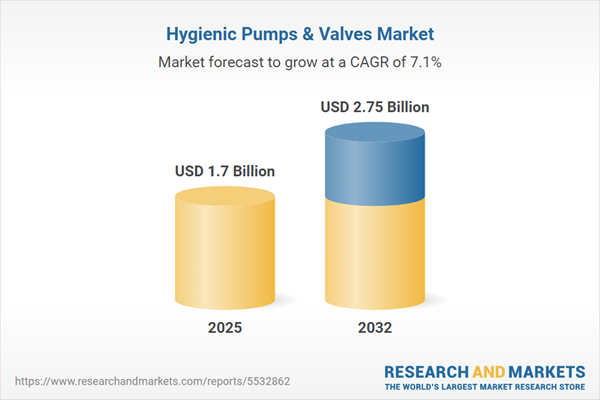Speak directly to the analyst to clarify any post sales queries you may have.
The hygienic pumps and valves market is entering a period of transformation as manufacturers and end users across regulated sectors demand high-precision, aseptic processing and data-driven, sustainable equipment. Strategic innovation, evolving compliance, and global sourcing dynamics are driving new opportunities for decision-makers seeking growth and risk mitigation in critical fluid handling.
Market Snapshot: Hygienic Pumps & Valves Market Trends
The hygienic pumps and valves market grew from USD 1.59 billion in 2024 to USD 1.70 billion in 2025. It is expected to continue growing at a CAGR of 7.09%, reaching USD 2.75 billion by 2032. This robust trajectory reflects accelerating adoption across pharmaceuticals, food and beverage, biotechnology, and chemical processing. Market expansion is being shaped by regulatory changes, technological advancements, and evolving supply chain strategies in the fluid handling industry.
Scope & Segmentation
- Product Types: Centrifugal pumps, positive displacement pumps (lobe, peristaltic, rotary gear), ball valves, butterfly valves, diaphragm valves.
- End Use Industries: Chemical, cosmetics and personal care, food and beverage, pharmaceutical and biotech sectors.
- End Connection Types: Butt weld, sanitary flange, threaded, tri clover fittings.
- Material Selection: Alloys, carbon steel, plastic, stainless steel.
- Operation Modes: Electric, hydraulic, manual, pneumatic actuation.
- Pressure Ratings: High, medium, and low pressure designs.
- Regional Coverage: Americas (North America—United States, Canada, Mexico; Latin America—Brazil, Argentina, Chile, Colombia, Peru), Europe, Middle East & Africa (United Kingdom, Germany, France, Russia, Italy, Spain, Netherlands, Sweden, Poland, Switzerland, United Arab Emirates, Saudi Arabia, Qatar, Turkey, Israel, South Africa, Nigeria, Egypt, Kenya), Asia-Pacific (China, India, Japan, Australia, South Korea, Indonesia, Thailand, Malaysia, Singapore, Taiwan).
- Key Companies Analyzed: Alfa Laval AB, SPX FLOW Inc., GEA Group, Flowserve Corporation, KSB SE & Co. KGaA, IDEX Corporation, Graco Inc., Pentair plc, ITT Inc., Circor International, Inc.
Key Takeaways for Senior Decision-Makers
- Regulatory rigor and quality standards increasingly influence equipment design and supplier selection in hygienic fluid handling, shaping procurement and long-term asset performance.
- End users are seeking modular, smart system architectures that enable real-time monitoring and rapid changeovers, directly impacting operational flexibility and risk management.
- Sustainability requirements are driving material and actuator selection, as manufacturers respond to corporate and regional environmental commitments with advanced, durable designs.
- Global supply chain complexities and recent tariff adjustments have compelled strategic shifts toward local manufacturing, diversified sourcing, and collaborative partnerships.
- Emergence of digitalization—including predictive analytics and integrated sensors—is redefining maintenance approaches, reducing unscheduled downtime, and supporting lifecycle cost optimization.
Tariff Impact on Sourcing and Costs
Recent tariff introductions on stainless steel alloys, polymers, and precision components are reshaping cost structures for U.S.-based manufacturers and end users. Many companies are increasing local production capacity and broadening supplier networks to mitigate these pressures. By building collaborative procurement agreements and standardizing product platforms, industry players are managing volatility and maintaining supply chain resilience.
Methodology & Data Sources
This report uses a mixed-method research approach blending primary interviews with executives, engineers, and regulatory experts, as well as secondary documentation review. Vendor catalogs, regulatory archives, technical white papers, and financial disclosures were rigorously analyzed. The research integrates supply chain modeling and performance benchmarking to provide strategic insights tailored to B2B stakeholders in the hygienic pumps and valves market.
Why This Report Matters
- Supports informed capital and procurement decisions by mapping shifting regulatory, technological, and supply dynamics across major fluid handling segments.
- Empowers strategy development by highlighting cross-regional opportunities and pinpointing competitive advantages via modularity, digitalization, and sustainability.
- Enables risk mitigation and agility planning by detailing recent tariff effects and emerging best practices in sourcing and supplier collaboration.
Conclusion
This analysis provides a comprehensive view of the evolving hygienic pumps and valves market, equipping leaders with actionable intelligence to drive growth, operational resilience, and strategic differentiation in regulated fluid handling environments.
Additional Product Information:
- Purchase of this report includes 1 year online access with quarterly updates.
- This report can be updated on request. Please contact our Customer Experience team using the Ask a Question widget on our website.
Table of Contents
3. Executive Summary
4. Market Overview
7. Cumulative Impact of Artificial Intelligence 2025
Companies Mentioned
The companies profiled in this Hygienic Pumps & Valves market report include:- Alfa Laval AB
- SPX FLOW, Inc.
- GEA Group Aktiengesellschaft
- Flowserve Corporation
- KSB SE & Co. KGaA
- IDEX Corporation
- Graco Inc.
- Pentair plc
- ITT Inc.
- Circor International, Inc.
Table Information
| Report Attribute | Details |
|---|---|
| No. of Pages | 198 |
| Published | November 2025 |
| Forecast Period | 2025 - 2032 |
| Estimated Market Value ( USD | $ 1.7 Billion |
| Forecasted Market Value ( USD | $ 2.75 Billion |
| Compound Annual Growth Rate | 7.0% |
| Regions Covered | Global |
| No. of Companies Mentioned | 11 |









